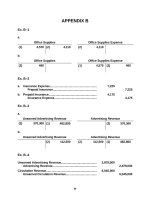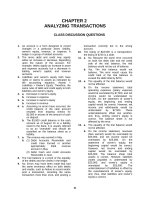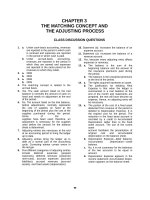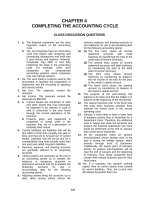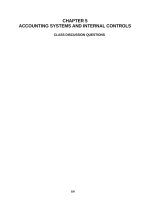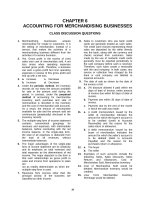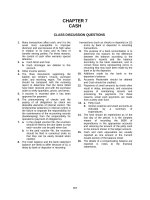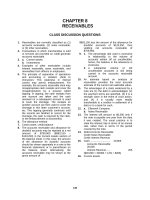Solution manual microeconomics 7e by pindyck ch15
Bạn đang xem bản rút gọn của tài liệu. Xem và tải ngay bản đầy đủ của tài liệu tại đây (256.63 KB, 15 trang )
To download more slides, ebook, solutions and test bank, visit
Chapter 15: Investment, Time and Capital Markets
CHAPTER 15
INVESTMENT, TIME, AND CAPITAL MARKETS
TEACHING NOTES
The primary focus of this chapter is on how firms make capital investment decisions, though
the chapter also includes some topical applications of the net present value criterion. You will notice
that the chapter does not derive the rate of time preference; instead, it introduces students to financial
decision-making. The key sections to cover are 15.1, 15.2, and 15.4, which cover stocks and flows,
discounted present value, and the net present value criterion, respectively. Section 15.4 also discusses
real and nominal discount rates. You can then pick and choose among the remaining sections
depending on time and interest. Each of the special topics is briefly described below.
Section 15.3 explains how to find the value of a bond (including a perpetuity) using present
discounted value calculations. Once students understand the effective yield on a bond, you could
introduce the internal rate of return, IRR, and then discuss why the net present value, NPV, is
superior to the IRR criterion for making capital investment decisions. For a comparison of IRR and
NPV see, for example, Brealey and Myers, Principles of Corporate Finance (McGraw-Hill).
Section 15.5 discusses risk and the risk-free discount rate. You can motivate the discussion of
risk by considering the probability of default by different classes of borrowers (this introduces the
discussion of credit markets that will take place in Section 17.1). This section introduces students to
the Capital Asset Pricing Model. To understand the CAPM, it helps if students are familiar with
Chapter 5, particularly Section 5.4, “The Demand for Risky Assets.” The biggest stumbling block is the
definition of β. If students have an intuitive feel for β, they may use Equation (15.7) to calculate the
appropriate discount rate for a firm.
Section 15.6 applies the NPV criterion to investment decisions by consumers, leading to a
wealth of applications. Example 15.4 presents Hausman’s analysis of the decision to purchase an air
conditioner, which comes to some interesting conclusions about the discount rates consumers use. You
might use this as the basis for class discussion about whether the results of the study seem reasonable.
Section 15.7 considers investments in human capital. Human capital theory is a topic that
bridges Chapters 14 and 15 since greater investment in human capital typically leads to higher wages
for the worker. Students are usually quite interested in the calculation of the NPV of a college
education and the return on an MBA degree.
Section 15.8 examines depletable resources and presents Hotelling’s model of exhaustible
resources. This example is a particularly good topic for class discussion given current oil prices. If you
want to explore the resources area in further detail, you could also consider renewable resources such
as timber. A straightforward treatment can be found in Chiang, Fundamental Methods of
Mathematical Economics (McGraw-Hill, 1984) pp. 300-301. Note that these problems involve calculus
but may be solved geometrically.
Section 15.9 discusses how interest rates are determined in the market for loanable funds and
defines a variety of interest rates including the federal funds and commercial paper rates. If you have
introduced students to the marginal rate of time preference, you can complete the analysis by
introducing the simple two-period model of consumption and savings, since that model does not appear
anywhere in the text. The axes are consumption (in dollars) today and at some future date such as
next year. The budget line shows the rate at which consumption today may be transformed into future
consumption at interest rate R. Indifference curves depend on the consumer’s rate of time preference
and determine the optimal consumption today and in the future. Covering this model would be
especially useful if your students were concerned that savings did not appear in the consumer choice
model back in Chapters 3 and 4.
274
Copyright © 2009 Pearson Education, Inc. Publishing as Prentice Hall.
To download more slides, ebook, solutions and test bank, visit
Chapter 15: Investment, Time and Capital Markets
REVIEW QUESTIONS
1. A firm uses cloth and labor to produce shirts in a factory that it bought for $10 million.
Which of its factor inputs are measured as flows and which as stocks? How would your
answer change if the firm had leased a factory instead of buying one? Is its output
measured as a flow or a stock? What about profit?
Inputs that are purchased and used up during a particular time period are flows. Flow
variables can be measured over time periods such as hours, days, weeks, months, or
years. Inputs measured at a particular point in time are stocks. All stock variables
have an associated flow variable. At any particular time, a firm will have a stock of
buildings and machines that it owns, which are stock variables. During a given time
period, as the firm uses its capital stock, that stock will depreciate, and this
depreciation is a flow. In this question, cloth and labor are flows, while the factory is a
stock. If the firm instead leases the building, the factory is still a stock variable that is
owned in this case by someone else. The firm would pay rent during a particular time
period, which would be a flow just like depreciation when the firm owns the capital
stock. Output is always a flow variable that is measured over some time period. Since
profit is the difference between revenues and costs over some given time period, it is
also a flow.
2. How do investors calculate the net present value of a bond? If the interest rate is 5
percent, what is the present value of a perpetuity that pays $1000 per year forever?
The present value of a bond is the sum of discounted values of each payment to the
bond holder over the life of the bond. This involves the payment of interest in each
period and then the repayment of the principal at the end of the bond’s life. A
perpetuity involves the payment of interest in every future period forever, with no
A
repayment of the principal. The present discounted value of a perpetuity is PDV = ,
R
where A is the annual payment and R is the annual interest rate. If A = $1000 and R =
$1,000
= $20,000 .
0.05, PDV =
0.05
3. What is the effective yield on a bond? How does one calculate it? Why do some corporate
bonds have higher effective yields than others?
The effective yield is the interest rate that equates the present value of a bond’s
payment stream with the bond’s market price. The present discounted value of a
payment made in the future is
PDV = FV/(1 + R)t,
where t is the length of time before payment. The bond’s selling price is its PDV. The
payments it makes are the future values, FV, paid in time t. Thus, the selling price P
equals P =
A
A
A
I
+
+ ... +
+
, where A is the annual interest
2
N
1 + R (1 + R )
(1 + R )
(1 + R ) N
payment, I is the principal repayment, and N is the number of years until maturity.
We must solve for R, which is the bond’s effective yield. The effective yield is
determined by the interaction of buyers and sellers in the bond market. Some
corporate bonds have higher effective yields because they are thought to be a more
risky investment, and hence buyers must be rewarded with a higher rate of return so
that they will be willing to hold the bonds. Higher rates of return imply a lower
present discounted value. If bonds have the same coupon payments, the bonds of the
riskiest firms will sell for less than the bonds of the less risky firms.
275
Copyright © 2009 Pearson Education, Inc. Publishing as Prentice Hall.
To download more slides, ebook, solutions and test bank, visit
Chapter 15: Investment, Time and Capital Markets
4. What is the Net Present Value (NPV) criterion for investment decisions? How does one
calculate the NPV of an investment project? If all cash flows for a project are certain, what
discount rate should be used to calculate NPV?
The Net Present Value criterion for investment decisions says to invest if the present
value of the expected future cash flows from an investment is larger than the cost of the
investment (Section 15.4). We calculate the NPV by (1) determining the present
discounted value of all future cash flows and (2) subtracting the discounted value of all
costs, present and future. To discount both income and cost, the firm should use a
discount rate that reflects its opportunity cost of capital, the next highest return on an
alternative investment of similar riskiness. Therefore, the risk-free interest rate
should be used if the cash flows are certain.
5. You are retiring from your job and are given two options. You can accept a lump sum
payment from the company, or you can accept a smaller annual payment that will
continue for as long as you live. How would you decide which option is best? What
information do you need?
The best option is the one that has the highest present discounted value. The lump
sum payment has a present discounted value equal to the amount of the lump sum
payment. To calculate the present discounted value of the payment stream, you need
to know approximately how many years you might live. If you made a guess of 25
years you could then discount each of the 25 payments back to the current year and
add them up to see how this sum compares to the lump sum payment. The discount
factor would be the rate of return you expect to earn each year when you invest the
lump sum payment. Finally, you must consider the time and risks involved in
managing a lump sum on your own and decide if it is better or easier to just take the
annual payments. The critical information you need to make this decision is how
long you will live and the rate of return you will earn on your investment each year.
Unfortunately, neither is knowable with certainty.
6. You have noticed that bond prices have been rising over the past few months. All else
equal, what does this suggest has been happening to interest rates? Explain.
This suggests that interest rates have been falling because bond prices and interest
rates are inversely related. When the price of a bond (with a fixed stream of future
payments) rises, then the effective yield on the bond falls. So if bond prices have
been rising, the yields on bonds must be falling, and the only way people will be
willing to hold bonds whose yields have fallen is if interest rates in general have also
fallen.
7. What is the difference between a real discount rate and a nominal discount rate? When
should a real discount rate be used in an NPV calculation and when should a nominal rate
be used?
The real discount rate is net of inflation, whereas the nominal discount rate includes
inflationary expectations. The real discount rate is equal to the nominal discount rate
minus the expected rate of inflation. If cash flows are in real terms, the appropriate
discount rate is the real rate, but if the cash flows are in nominal terms, a nominal
discount rate should be used. For example, in applying the NPV criterion to a
manufacturing decision, if future prices of inputs and outputs are projected using
current dollars (and have not been increased to account for future inflation), a real
discount rate should be used to determine whether the NPV is positive. On the other
hand, if the future dollar amounts have been adjusted to account for inflation, then a
nominal discount rate should be used. In sum, all numbers should either be expressed
in real terms or nominal terms, but not a mix.
276
Copyright © 2009 Pearson Education, Inc. Publishing as Prentice Hall.
To download more slides, ebook, solutions and test bank, visit
Chapter 15: Investment, Time and Capital Markets
8. How is risk premium used to account for risk in NPV calculations? What is the difference
between diversifiable and nondiversifiable risk? Why should only nondiversifiable risk
enter into the risk premium?
To determine the present discounted value of a cash flow, the discount rate should
reflect the riskiness of the project generating the cash flow. The risk premium is the
difference between a discount rate that reflects the riskiness of the cash flow and a
discount rate for a risk-free flow, e.g., the discount rate associated with a short-term
government bond. The higher the riskiness of a project, the higher the risk premium.
Diversifiable risk can be eliminated by investing in many projects. Hence, an efficient
capital market will not compensate an investor for taking on risk that can be
eliminated costlessly. Nondiversifiable risk is that part of a project’s risk that cannot
be eliminated by investing in a large number of other projects. It is that part of a
project’s risk which is correlated with the portfolio of all projects available in the
market. Since investors can eliminate diversifiable risk, they cannot expect to earn a
risk premium on diversifiable risk.
9. What is meant by the “market return” in the Capital Asset Pricing Model (CAPM)? Why
is the market return greater than the risk-free interest rate? What does an asset’s “beta”
measure in the CAPM? Why should high-beta assets have a higher expected return than
low-beta assets?
In the Capital Asset Pricing Model (CAPM), the market return is the rate of return on
the portfolio of all assets in the market. Thus the market return reflects only
nondiversifiable risk.
Since the market portfolio has no diversifiable risk, the market return reflects the risk
premium associated with holding one unit of nondiversifiable risk. The market rate of
return is greater than the risk-free rate of return, because risk-averse investors must
be compensated with higher average returns for holding a risky asset.
An asset’s beta reflects the sensitivity (covariance) of the asset’s return with the return
on the market portfolio. An asset with a high beta will have a greater expected return
than a low-beta asset, because the high-beta asset has greater nondiversifiable risk
than the low-beta asset.
10. Suppose you are deciding whether to invest $100 million in a steel mill. You know the
expected cash flows for the project, but they are risky – steel prices could rise or fall in the
future. How would the CAPM help you select a discount rate for an NPV calculation?
To evaluate the net present value of a $100 million investment in a steel mill, you
should use the stock market’s current evaluation of firms that own steel mills as a
guide to selecting the appropriate discount rate. For example, you would (1) identify
nondiversified steel companies that are primarily involved in steel production, (2)
determine the beta associated with stocks issued by those companies (this can be done
statistically or by relying on a financial service that publishes stock betas, such as
Value Line), and (3) take a weighted average of these betas, where the weights are
equal to each firm’s assets divided by the sum of all the nondiversified steel firms’
assets. With an estimate of beta, plus estimates of the expected market and risk-free
rates of return, you could infer the discount rate using Equation (15.7) in the text:
Discount rate = r f + β ( rm − r f ) .
277
Copyright © 2009 Pearson Education, Inc. Publishing as Prentice Hall.
To download more slides, ebook, solutions and test bank, visit
Chapter 15: Investment, Time and Capital Markets
11. How does a consumer trade off current and future costs when selecting an air
conditioner or other major appliance? How could this selection be aided by an NPV
calculation?
There are two major costs to be considered when purchasing a durable good: the initial
purchase price and the cost of operating (and perhaps repairing) the appliance over its
lifetime. Since these costs occur at different points in time, consumers should calculate
the present discounted value of all the future costs and add that to the purchase price
to determine the total cost of the appliance. This is what an NPV calculation does, so
selecting the best appliance can be aided by doing an NPV calculation using the
consumer’s opportunity cost of money as the discount rate.
12. What is meant by the “user cost” of producing an exhaustible resource? Why does price
minus extraction cost rise at the rate of interest in a competitive market for an exhaustible
resource?
In addition to the marginal cost of extracting the resource and preparing it for sale,
there is an additional opportunity cost arising from the depletion of the resource,
because producing and selling a unit today makes that unit unavailable for production
and sale in the future. User cost is the difference between price and the marginal cost
of production. User cost rises over time because as reserves of the resource become
depleted, the remaining reserves become more valuable.
Given constant demand over time, the price of the resource minus its marginal cost of
extraction, P – MC, should rise over time at the rate of interest. If P – MC rises faster
than the rate of interest, no extraction should occur in the present period, because
holding the resource for another year would earn a higher profit a year from now than
selling the resource now and investing the proceeds for another year. If P – MC rises
more slowly than the rate of interest, current extraction should increase, thus
increasing supply, lowering the equilibrium price, and decreasing the return on
producing the resource. In equilibrium, the price of an exhaustible resource rises at the
rate of interest.
13. What determines the supply of loanable funds? The demand for loanable funds? What
might cause the supply or demand for loanable funds to shift? How would such a shift
affect interest rates?
The supply of loanable funds is determined by the interest rate offered to savers. A
higher interest rate induces households to consume less today (save) in favor of greater
consumption in the future. The demand for loanable funds comes from consumers who
wish to consume more today than tomorrow or from investors who wish to borrow
money. Demand depends on the interest rate at which these two groups can borrow.
Several factors can shift the demand and supply of loanable funds. For example, a
recession decreases demand at all interest rates, shifting the demand curve inward and
causing the equilibrium interest rate to fall. On the other hand, the supply of loanable
funds will shift out if the Federal Reserve increases the money supply, again causing
the interest rate to fall.
278
Copyright © 2009 Pearson Education, Inc. Publishing as Prentice Hall.
To download more slides, ebook, solutions and test bank, visit
Chapter 15: Investment, Time and Capital Markets
EXERCISES
1. Suppose the interest rate is 10 percent. If $100 is invested at this rate today, how much
will it be worth after one year? After two years? After five years? What is the value today
of $100 paid one year from now? Paid two years from now? Paid five years from now?
The future value, FV, of $100 invested today at an interest rate of 10 percent is
FV = $100 + ($100)(0.10) = $110.
Two years from now we will earn interest on the original $100 (interest = $10) and we
will earn interest on the interest from the first year, i.e., ($10)(0.10) = $1. Thus, our
investment will be worth $100 + $10 (from the first year) + $10 (from the second year)
+ $1 (interest on the first year’s interest) = $121.
Algebraically, FV = PDV(1 + R)t, where PDV is the present discounted value (or initial
amount) of the investment, R is the interest rate, and t is the number of years. After
two years,
2
FV = PDV(1 + R)t = ($100)(1.1) = ($100)(1.21) = $121.00.
After five years
5
FV = PDV(1 + R)t = ($100)(1.1) = ($100)(1.61051) = $161.05.
To find the present discounted value of $100 paid one year from now, we ask how much
is needed to invest today at 10 percent to have $100 one year from now. Using our
formula for FV, we solve for PDV as a function of FV:
-
PDV = (FV)(1 + R) t.
With t = 1, R = 0.10, and FV = $100,
-1
PDV = (100)(1.1) = $90.91.
-2
With t = 2, PDV = (100)(1.1) = $82.64,
-5
With t = 5, PDV = (100)(1.1) = $62.09.
2. You are offered the choice of two payment streams: (a) $150 paid one year from now and
$150 paid two years from now; (b) $130 paid one year from now and $160 paid two years
from now. Which payment stream would you prefer if the interest rate is 5 percent? If it is
15 percent?
To compare two income streams, calculate the present discounted value of each and
choose the one with the higher present discounted value. We use the formula PDV =
FV(1 + R) t for each cash flow. Stream (a) has two payments:
-1
-2
PDVa = FV1(1 + R) + FV2(1 + R)
-1
-2
PDVa = ($150)(1.05) + ($150)(1.05) , or
PDVa = $142.86 + 136.05 = $278.91.
Stream (b) has two payments:
-1
-2
PDVb = ($130)(1.05) + ($160)(1.05) , or
PDVb = $123.81 + $145.12 = $268.93.
279
Copyright © 2009 Pearson Education, Inc. Publishing as Prentice Hall.
To download more slides, ebook, solutions and test bank, visit
Chapter 15: Investment, Time and Capital Markets
At an interest rate of 5 percent, you should select (a).
If the interest rate is 15 percent, the present discounted values of the two income
streams would be:
-1
-2
PDVa = ($150)(1.15) + ($150)(1.15) , or
PDVa = $130.43 + $113.42 = $243.85, and
-1
-2
PDVb = ($130)(1.15) + ($160)(1.15) , or
PDVb = $113.04 + $120.98 = $234.02.
You should still select (a).
3. Suppose the interest rate is 10 percent. What is the value of a coupon bond that pays $80
per year for each of the next five years and then makes a principal repayment of $1000 in
the sixth year? Repeat for an interest rate of 15 percent.
The value of the bond is the present discounted value, PDV, of the stream of payments
made by the bond over the next six years. The PDV of each payment is:
FV
PDV =
,
(1+ R) t
where R is the interest rate, equal to 10 percent (i.e., 0.10), and t is the number of years
in the future. The value of all coupon payments over five years is therefore
PDV =
80
80
80
80
80
, or
+
+
+
+
(1 + R) (1 + R) 2 (1 + R) 3 (1 + R) 4 (1 + R ) 5
1
1
1
1
1 ⎞
PDV = 80⎛⎝
+
+
+
+
= $303.26.
1.1 1.21 1.331 1.4641 1.61051⎠
The present value of the final payment of $1000 in the sixth year is
PDV =
$1,000
.
11
6
=
$1,000
= $564.47.
1.771
Thus, the present value of the bond is $303.26 + $564.47 = $867.73.
With an interest rate of 15 percent, the value of the bond is
PDV = 80(0.870 + 0.756 + 0.658 + 0.572 + 0.497) + (1000)(0.432), or
PDV = $268.17 + $432.33 = $700.50.
As the interest rate increases, the value of the bond decreases.
4. A bond has two years to mature. It makes a coupon payment of $100 after one year and
both a coupon payment of $100 and a principal repayment of $1000 after two years. The
bond is selling for $966. What is its effective yield?
We want to know the interest rate that will yield a present value of $966 for an income
stream of $100 after one year and $1100 after two years. Find i such that
-1
-2
966 = (100)(1 + i) + (1100)(1 + i) .
280
Copyright © 2009 Pearson Education, Inc. Publishing as Prentice Hall.
To download more slides, ebook, solutions and test bank, visit
Chapter 15: Investment, Time and Capital Markets
Algebraic manipulation yields
2
966(1 + i) = 100(1 + i) + 1100, or
2
966 + 1932i + 966i – 100 – 100i – 1100 = 0, or
2
966i + 1832i – 234 = 0.
Using the quadratic formula to solve for i,
i = 0.12 or –2.017.
Since –2.017 does not make economic sense, the effective yield is 12 percent.
5. Equation (15.5) (page 563) shows the net present value of an investment in an electric
motor factory. Half of the $10 million cost is paid initially and the other half after a year.
The factory is expected to lose money during its first two years of operation. If the discount
rate is 4 percent, what is the NPV? Is the investment worthwhile?
► Note: The answer at the end of the book (first printing) reports some incorrect values, and the NPV
is wrong. Correct values are given below.
Using R = 0.04, Equation 15.5 becomes
NPV = − 5 −
5
(1.04)
−
1
(1.04)
2
−
0.5
(1.04 )
3
+
0.96
(1.04 )
4
+
0.96
( 1.04)
5
+L +
0.96
( 1.04 )
20
+
1
(1.04 ) 20
.
Calculating the NPV we find:
NPV = –5 – 4.808 – 0.925 – 0.445 + 0.821 + 0.789 + 0.759 + 0.730 + 0.701 + 0.674 +
0.649 + 0.624 + 0.600 + 0.577 + 0.554 + 0.533 + 0.513 + 0.493 + 0.474 + 0.456 + 0.438 +
0.456 = –0.338.
The investment loses $338,000 and is not worthwhile. However, were the discount rate
3%, the NPV = $866,000, and the investment would be worth undertaking.
6. The market interest rate is 5 percent and is expected to stay at that level. Consumers
can borrow and lend all they want at this rate. Explain your choice in each of the following
situations:
a. Would you prefer a $500 gift today or a $540 gift next year?
The present value of $500 today is $500. The present value of $540 next year is
$540.00
= $514.29.
1.05
Therefore, you should prefer the $540 next year.
b. Would you prefer a $100 gift now or a $500 loan without interest for four years?
If you take the $500 loan, you can invest it for the four years and then pay back the
$500. The future value of the $500 is
500(1.05) 4 = $607.75 .
After you pay back the $500 you will have $107.75 left to keep. The future value of the
$100 gift is
100(1.05)4 = $121.55.
You should take the $100 gift.
281
Copyright © 2009 Pearson Education, Inc. Publishing as Prentice Hall.
To download more slides, ebook, solutions and test bank, visit
Chapter 15: Investment, Time and Capital Markets
c. Would you prefer a $350 rebate on an $8000 car or one year of financing for the full
price of the car at 0 percent interest?
The interest rate is 0 percent, which is 5 percent less than the current market rate.
You save $400 = (0.05)($8000) one year from now. The present value of this $400 is
$400
= $380.95.
1.05
This is greater than $350. Therefore, choose the financing.
d. You have just won a million-dollar lottery and will receive $50,000 a year for the next
20 years. How much is this worth to you today?
If you get the first year’s payment immediately (as is usually the case), the PDV of the
payments of $50,000 per year for 20 years is less than two-thirds of $1 million.
PDV = 50,000 +
50,000 50,000 50,000
50,000
50,000
+
+
+ ... +
+
= $654,266.04 .
2
3
18
1.05
(1.05)
(1.05)
(1.05)
(1.05)19
e. You win the “honest million” jackpot. You can have $1 million today or $60,000 per
year for eternity (a right that can be passed on to your heirs). Which do you prefer?
The present discounted value of the $60,000 perpetuity is $60,000/0.05 = $1,200,000,
which makes it advisable take the $60,000 per year payment. Note that it takes 32
years before the PDV of the perpetuity exceeds $1,000,000, so if you don’t expect to live
that long, you should take the perpetuity only if you care about your heirs.
f.
In the past, adult children had to pay taxes on gifts over $10,000 from their parents,
but parents could make interest-free loans to their children. Why did some people
call this policy unfair? To whom were the rules unfair?
Any gift of $N from parent to child could be made without taxation by lending the child
$ N (1 + r )
. For example, to avoid taxes on a $50,000 gift, the parent would lend the
r
child $550,000, assuming a 10 percent interest rate. With that money, the child could
earn $55,000 in interest after one year and still have $500,000 to pay back to the
parent. The present value of the remaining $55,000 one year from now is $50,000.
People of more moderate incomes would find these rules unfair: they might only be able
to afford to give the child $50,000 directly, but it would not be tax free.
282
Copyright © 2009 Pearson Education, Inc. Publishing as Prentice Hall.
To download more slides, ebook, solutions and test bank, visit
Chapter 15: Investment, Time and Capital Markets
7. Ralph is trying to decide whether to go to graduate school. If he spends two years in
graduate school, paying $15,000 tuition each year, he will get a job that will pay $60,000 per
year for the rest of his working life. If he does not go to school, he will go into the work
force immediately. He will then make $30,000 per year for the next three years, $45,000 for
the following three years, and $60,000 per year every year after that. If the interest rate is
10 percent, is graduate school a good financial investment?
After the sixth year, Ralph’s income will be the same with or without the graduate
school education, so we can ignore all income after the first six years. With graduate
school, the present value of income for the next six years (assuming all payments occur
at the end of the year) is
−
$15,000 $15,000 $60,000 $60,000 $60,000 $60,000
−
+
+
+
+
= $131,150.35.
(1.1)1
(1.1)2
(1.1)3
(1.1)4
(1.1)5
(1.1)6
Without graduate school, the present value of income for the next six years is
$30,000 $30,000 $30,000 $45,000 $45,000 $45,000
+
+
+
+
+
= $158,683.95.
(1.1)1
(1.1)2
(1.1)3
(1.1)4
(1.1)5
(1.1)6
The payoff from graduate school is not large enough to justify the foregone income and
tuition expense while Ralph is in school; he should therefore not go to school.
8. Suppose your uncle gave you an oil well like the one described in Section 15.8. (Marginal
production cost is constant at $10.) The price of oil is currently $20 but is controlled by a
cartel that accounts for a large fraction of total production. Should you produce and sell all
your oil now or wait to produce? Explain your answer.
If a cartel accounts for a large fraction of total production, today’s price minus marginal
cost, P t – MC will rise at a rate less than the rate of interest. This is because the cartel
will choose output such that marginal revenue minus MC rises at the rate of interest.
Since price exceeds marginal revenue, P t – MC will rise at a rate less than the rate of
interest. So, to maximize net present value, all your oil should be sold today, and your
profits should be invested at the rate of interest.
9. You are planning to invest in fine wine. Each case costs $100, and you know from
1/2
experience that the value of a case of wine held for t years is 100t . One hundred cases of
wine are available for sale, and the interest rate is 10 percent.
► Note: The answer for part (b) at the end of the book (first printing) is incorrect. The exponent on e
should be negative, and the NPV should be –5.62, as shown below.
a. How many cases should you buy, how long should you wait to sell them, and how
much money will you receive at the time of their sale?
One way to get the answer is to compare holding a case of wine to putting your $100 in
the bank. The bank pays interest of 10 percent, while the wine increases in value at
the rate of
d (value)
50t −0.5 1
dt
=
= .
value
100t 0.5 2t
283
Copyright © 2009 Pearson Education, Inc. Publishing as Prentice Hall.
To download more slides, ebook, solutions and test bank, visit
Chapter 15: Investment, Time and Capital Markets
As long as t < 5, the return on wine is greater than or equal to 10 percent. When t > 5,
the return on wine drops below 10 percent. Therefore, t = 5 is the time to switch your
wealth from wine to the bank. Since each case is a good investment, you should buy all
100 cases.
Another way to get the answer is to use an advanced formula for calculating the PDV.
This formula assumes continuous compounding rather than annual compounding. If
0.5
you buy a case and sell it after t years, you pay $100 now and receive 100t when it is
sold. The NPV of this investment is
NPV = −100 + e − n (100 t 0.5 ) = −100 + e −0.1t (100 t 0.5 )
If you do buy a case, you will want to choose t to maximize the NPV. This implies
differentiating with respect to t to obtain the necessary condition that
dNPV
= (e −0.1t )(50 t −0.5 ) − (0.1e −0.1t )(100 t 0.5 ) = 0 .
dt
0.1t
Multiply both sides of the first order condition by e
to obtain
50 t −0.5 − 10 t 0.5 = 0 , or t = 5.
If you held the case for 5 years, the NPV would be
− 100 + e ( −0.1)(5) (100)(5 0.5 ) = $35.62 .
[Note that you get a slightly different NPV if you use annual discounting: NPV = –100
+ 223.61/(1.1)5 = 38.84.]
Therefore, you should buy a case and hold it for five years. The value of the case at the
0.5
time of sale is ($100)(5 ) = $223.61. Again, you should buy all 100 cases.
b. Suppose that at the time of purchase, someone offers you $130 per case immediately.
Should you take the offer?
You just bought the wine and are offered $130 for resale, so you would make an
immediate profit of $30. However, if you hold the wine for 5 years, the NPV of your
profit is $35.62 as shown in part (a). Therefore, the NPV if you sell immediately rather
than hold for 5 years is $30 – 35.62 = –$5.62, so you should not sell. You are better off
holding the wine for 5 years rather than selling it for a quick profit.
How would your answers change if the interest rate were only 5 percent?
If the interest rate changes from 10 percent to 5 percent, the NPV calculation is
-0.05t
NPV = –100 + (e
0.5
)(100t ).
As before, we maximize this expression:
dNPV
= (e −0.05t )(50 t −0.5 ) − (0.05e −0.05t )(100 t 0.5 ) = 0 .
dt
0.05t
By multiplying both sides of the first order condition by e
-0.5
50t
0.5
– 5t
, it becomes
= 0,
or t = 10. If we hold the case 10 years, NPV is
− 100 + e ( −0.05)(10 ) (100)(10 0.5 ) = $91.80 .
284
Copyright © 2009 Pearson Education, Inc. Publishing as Prentice Hall.
To download more slides, ebook, solutions and test bank, visit
Chapter 15: Investment, Time and Capital Markets
With a lower interest rate, it pays to hold onto the wine longer before selling it, because
the value of the wine is increasing at the same rate as before. Again, you should buy
all 100 cases.
Now if someone offers you $130 immediately, you should definitely not sell. By selling
you make a quick $30 profit per case, but by holding for 10 years the present value of
your profit is $91.80 per case.
10. Reexamine the capital investment decision in the disposable diaper industry (Example
15.3) from the point of view of an incumbent firm. If P&G or Kimberly-Clark were to
expand capacity by building three new plants, they would not need to spend $60 million on
R&D before start-up. How does this advantage affect the NPV calculations in Table 15.5
(page 567)? Is the investment profitable at a discount rate of 12 percent?
If the only change in the cash flow for an incumbent firm is the absence of an initial
pre-2010 $60 million R&D expenditure, then the NPV calculations in Table 15.5 simply
increase by $60 million for each discount rate:
Discount Rate:
0.05
0.10
0.15
NPV:
140.5
43.1
–15.1
To determine whether the investment is profitable at a discount rate of 12 percent, we
must recalculate the NPV. At 12 percent,
NPV = −60 −
+
93.4
56.6
40
40
40
40
40
40
−
+
+
+
+
+
+
2
3
4
5
6
7
1.12 (1.12)
(1.12)
(1.12)
(1.12)
(1.12)
(1.12)
(1.12) 8
40
40
40
40
40
40
40
+
+
+
+
+
+
=
9
10
11
12
13
14
(1.12)
(1.12)
(1.12)
(1.12)
(1.12)
(1.12)
(1.12)15
$16.3 million.
Thus, the incumbent would find it profitable to expand capacity.
11. Suppose you can buy a new Toyota Corolla for $20,000 and sell it for $12,000 after six
years. Alternatively, you can lease the car for $300 per month for three years and return it
at the end of the three years. For simplification, assume that lease payments are made
yearly instead of monthly – i.e., that they are $3600 per year for each of three years.
a. If the interest rate, r, is 4 percent, is it better to lease or buy the car?
To answer this question, compute the NPV of each option. The NPV of buying the car
is:
− 20,000 +
12,000
= −10,516.23 .
1.04 6
The NPV of leasing the car, assuming you have to pay at the beginning of each year, is:
−3,600 −
3,600 3,600
−
= −10,389.94.
1.04 1.042
In this case, you are better off leasing the car because the NPV is higher (i.e., less
negative).
285
Copyright © 2009 Pearson Education, Inc. Publishing as Prentice Hall.
To download more slides, ebook, solutions and test bank, visit
Chapter 15: Investment, Time and Capital Markets
b. Which is better if the interest rate is 12 percent?
Again, compute the NPV of each option. The NPV of buying the car is:
−20,000 +
12,000
= −13,920.43.
1.12 6
The NPV of leasing the car is:
−3,600 −
3,600 3,600
−
2 = −9,684.18.
1.12 1.12
You are still better off leasing the car because the NPV is higher.
c. At what interest rate would you be indifferent between buying and leasing the car?
You are indifferent between buying and leasing if the two NPV’s are equal or:
−20,000 +
12,000
3,600 3,600
−
.
6 = −3,600 −
(1+ r)
(1+ r) (1+ r )2
In this case, you need to solve for r. The easiest way to do this is to use a spreadsheet
and calculate the two NPV’s for different values of r. Observe first that the interest
rate will be something less than 4% given that at 4% the best option was to lease, and
as the interest rate rose to 12% leasing became even a better option. The interest rate
will be in the neighborhood of 3.8%.
r
NPV Buy
0.03
0.037
0.038
0.039
0.04
–9,950.19
–10,350.41
–10,406.06
–10,461.33
–10,516.23
NPV Lease
–10,488.49
–10,419.24
–10,409.45
–10,399.68
–10,389.94
11 (alternate). Suppose you can buy a new Toyota Corolla for $20,000 and sell it for $12,000
after six years. Alternatively, you can lease the car for $300 per month for three years and
return it at the end of the three years. Then you can lease another Corolla for another
three years for the same monthly payment. For simplification, assume that lease payments
are made yearly instead of monthly – i.e., that they are $3600 per year for each of three
years. Compare leasing the car for two consecutive three-year periods against owning the
car for six years.
a. If the interest rate, r, is 4 percent, is it better to lease or buy the car?
The NPV of owning the car is still
− 20,000 +
12,000
= −10,516.23 .
1.04 6
The NPV of leasing the car for six years is
− 3600 −
3600
3600
3600
3600
3600
−
−
−
−
= −19,626.56 .
2
3
4
1.04 (1.04)
(1.04)
(1.04)
(1.04)5
You should buy the car because the NPV is much higher (less negative).
286
Copyright © 2009 Pearson Education, Inc. Publishing as Prentice Hall.
To download more slides, ebook, solutions and test bank, visit
Chapter 15: Investment, Time and Capital Markets
b. Which is better if the interest rate is 12 percent?
As before, the NPV of owning the car is
−20,000 +
12,000
= −13,920.43.
1.12 6
The NPV of leasing the car is now
− 3600 −
3600
3600
3600
3600
3600
−
−
−
−
= −16,577.19 .
2
3
4
1.12 (1.12)
(1.12)
(1.12)
(1.12)5
You are still better off buying the car than leasing it.
c. At what interest rate would you be indifferent between buying and leasing the car?
You are indifferent between buying and leasing if the two NPV’s are equal:
− 20,000 +
3600
3600
3600
3600
3600
12,000
= −3600 −
−
−
−
−
6
2
3
4
1 + r (1 + r )
(1 + r )
(1 + r )
(1 + r )5
(1 + r )
In this case, you need to solve for r. The easiest way to do this is to use a spreadsheet
and calculate the two NPV’s for different values of r. Observe first that the interest
rate will be something greater than 12% given that at 4% the best option was to buy,
and as the interest rate rose to 12% buying was still better but by a smaller margin.
The interest rate that equates these two NPVs is almost exactly 16.6% as the
spreadsheet results below reveal.
r
0.16
0.165
0.166
0.167
0.17
NPV Buy
–15,074.69
–15,200.17
–15,224.82
–15,249.32
–15,321.94
NPV Lease
–15,387.46
–15,251.27
–15,224.35
–15,197.52
–15,117.65
12. A consumer faces the following decision: She can buy a computer for $1000 and $10 per
month for Internet access for three years, or she can receive a $400 rebate on the computer
(so that its cost is $600) but agree to pay $25 per month for three years for Internet access.
For simplification, assume that the consumer pays the access fees yearly (i.e., $10 per
month = $120 per year).
a. What should the consumer do if the interest rate is 3 percent?
Calculate the NPV in each case. Assuming that the Internet fees are paid at the
beginning of each year, the NPV of the first option is
−1,000 − 120 −
120 120
−
2 = −1,349.62.
1.03 1.03
The NPV of the second option with the rebate is
−600 − 300 −
300 300
−
= −1,474.04.
1.03 1.032
In this case, the first option gives a higher (less negative) NPV, so the consumer should
pay the $1000 now and pay $10 per month for Internet access.
287
Copyright © 2009 Pearson Education, Inc. Publishing as Prentice Hall.
To download more slides, ebook, solutions and test bank, visit
Chapter 15: Investment, Time and Capital Markets
b. What if the interest rate is 17 percent?
Repeat the calculations in part a using 17 percent. The NPV of the first option is
−1,000 − 120 −
120 120
−
= −1,310.23.
1.17 1.172
The NPV of the second option with the rebate is
−600 − 300 −
300 300
−
2 = −1,375.56.
1.17 1.17
In this case, the first option still gives a higher NPV, so the consumer should pay the
$1000 now and pay $10 per month for Internet access.
c. At what interest rate will the consumer be indifferent between the two options?
The consumer is indifferent between the two options if the NPV of each option is the
same. Therefore, set the NPVs equal to each other and solve for r:
120
120
300
300
−
= −600 − 300 −
−
2
1 + r (1+ r)
1 + r (1+ r )2
180
180
220 =
+
1+ r (1 + r) 2
−1,000 − 120 −
220(1 + r )2 = 180(1 + r ) + 180
220 r 2 + 260 r − 140 = 0.
Using the quadratic formula to solve for the interest rate r results in a value of
approximately r = 40.2%. So the consumer would have to have an extremely high
interest rate to make the rebate worthwhile.
288
Copyright © 2009 Pearson Education, Inc. Publishing as Prentice Hall.

